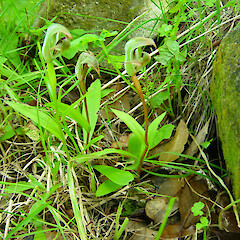Pterostylis areolata
Common name
greenhood
Synonyms
None
Family
Orchidaceae
Flora category
Vascular – Native
Endemic taxon
Yes
Endemic genus
No
Endemic family
No
Structural class
Orchids
NVS code
The National Vegetation Survey (NVS) Databank is a physical archive and electronic databank containing records of over 94,000 vegetation survey plots - including data from over 19,000 permanent plots. NVS maintains a standard set of species code abbreviations that correspond to standard scientific plant names from the Ngä Tipu o Aotearoa - New Zealand Plants database.
PTEARE
Chromosome number
2n = 44
Current conservation status
The conservation status of all known New Zealand vascular plant taxa at the rank of species and below were reassessed in 2017 using the New Zealand Threat Classification System (NZTCS) – more information about this can be found on the NZTCS website. This report includes a statistical summary and brief notes on changes since 2012 and replaces all previous NZTCS lists for vascular plants.
Please note, threat classifications are often suggested by authors when publications fall between NZTCS assessment periods – an interim threat classification status has not been assessed by the NZTCS panel.
- Conservation status of New Zealand indigenous vascular plants, 2017 . 2018. Peter J. de Lange, Jeremy R. Rolfe, John W. Barkla, Shannel P. Courtney, Paul D. Champion, Leon R. Perrie, Sarah M. Beadel, Kerry A. Ford, Ilse Breitwieser, Ines Schönberger, Rowan Hindmarsh-Walls, Peter B. Heenan and Kate Ladley. Department of Conservation. Source: NZTCS and licensed by DOC for reuse under the Creative Commons Attribution 4.0 International licence.
2017 | Not Threatened
Previous conservation statuses
2012 | Not Threatened
2009 | Not Threatened
2004 | Not Threatened
Distribution
Endemic. New Zealand: North Island (Tararua Ranges and possibly the Ruahines), South Island (widespread, mainly east of the main divide but also in Nelson and Fiordland).
Habitat
Lowland to subalpine. In short or tall tussock grassland, grey scrub, on the margins of wetlands and in open forest.
Detailed description
Terrestrial, tuberous, glabrous, spring to summer-green perennial herb, either solitary in forming small patches of 3–8 plants through vegetative extension. Plant at flowering 70–250 mm tall. Stem erect, smooth, dark green to reddish green, internodes < leaves. Leaves 2–4, with entire margins, shape changing from base to top of stem; lamina 30–90 × 10–25 mm, dark green to yellow-green, the lowest and those of non-flowering plants, broadly elliptic, elliptic, to obovate, apex obtuse to subacute, tapering to a reddish-green broadly winged petiole; uppermost leaves shorter, acute to acuminate; not overtopping the flower. Flower solitary, tipping forwards, large, dark green, green striped with white toward the back of the galea. Ovary erect. Dorsal sepal 30–35 mm tall, mostly erect then sharply horizontal to deflexed, apex shortly acuminate without caudae. Lateral sepals diverging at a narrow angle, apices acuminate to shortly caudate, rarely exceeding galea, usually narrowly spreading, decurved. Petals slightly shorter than dorsal sepal, very broad, apex acute. Labellum basally red, apex often distinctly darker; lamina elliptic, slightly arched, toward a narrowly obtuse, flat or pinched in apex. Column mostly taller than labellum; stigma elongate-ovate with a prominent truncate apex.
Manaaki Whenua Online Interactive Key
Similar taxa
Close to P. australis Hook.f. from which it differs by the fewer, consistently wider elliptic to obovate leaves which do not overtop the galea (rather than leaves which grade from the elliptic (rarely broadly elliptic) to almost linear-lanceolate and may or may not overtop the flower); and by the acuminate, only slightly caudate lateral sepals, and elongate-ovate uniformly red stigma. Unlike some southern populations of P. australis, the leaves of P. areolata are never finely denticulate.
Flowering
October–November
Flower colours
Green, White
Fruiting
November–February
Propagation technique
Difficult—should not be removed from the wild. Basic orchid mix consists of 2 parts medium coarse sand, ideally clean river sand; 2 parts soil, humus or leaf-mould; 1 part weathered sawdust or rotting wood; 1 part granulated bark. For Pterostylis shade of 50% and pots kept evenly moist.
Etymology
pterostylis: Winged column
areolata: Netted, with a network pattern between the veins
Where To Buy
Not commercially available.
Attribution
Fact Sheet prepared for NZPCN by P.J. de Lange 14 April 2007: Description adapted from Moore and Edgar (1970).
References and further reading
Moore LB, Edgar E. 1970. Flora of New Zealand, Volume II. Indigenous Tracheophyta: Monocotyledones except Gramineae. Government Printer, Wellington, NZ. 354 p.
NZPCN Fact Sheet citation
Please cite as: de Lange, P.J. (Year at time of access): Pterostylis areolata Fact Sheet (content continuously updated). New Zealand Plant Conservation Network. https://www.nzpcn.org.nz/flora/species/pterostylis-areolata/ (Date website was queried)



